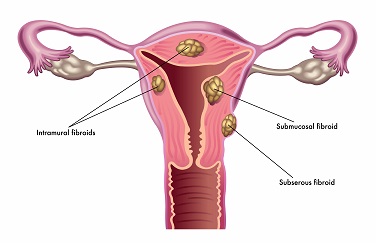 Uterine fibroids are growths within the uterus that can result in pain and discomfort and are made up of muscle and connective tissue; they may range in size from being microscopic to being larger than a grapefruit. One important fact about fibroids is that they are almost always noncancerous, but still may need to be treated for symptom relief. The rate at which they grow is unpredictable, and a woman may have more than one fibroid at a time. Fibroids are very common in women of childbearing age. According to several studies, as many as 3 out of 4 women have uterine fibroids sometime during their lives. It is important to understand that having fibroids does not increase a woman’s risk of developing uterine cancer.
Uterine fibroids are growths within the uterus that can result in pain and discomfort and are made up of muscle and connective tissue; they may range in size from being microscopic to being larger than a grapefruit. One important fact about fibroids is that they are almost always noncancerous, but still may need to be treated for symptom relief. The rate at which they grow is unpredictable, and a woman may have more than one fibroid at a time. Fibroids are very common in women of childbearing age. According to several studies, as many as 3 out of 4 women have uterine fibroids sometime during their lives. It is important to understand that having fibroids does not increase a woman’s risk of developing uterine cancer.
Types of Fibroids
- Submucosal Fibroids grow in the uterine lining and may cause heavier than normal menstrual bleeding.
- Subserosal Fibroids grow outwards from the outer covering of the uterus and may create pressure on the bladder resulting in incontinence and the constant urge to urinate.
- Intramural Fibroids grow within the muscular wall of the uterus.
- Pedunculated Fibroids have a stalk attaching them to the uterus and may grow either on the outside of the uterus or inside it.
What Causes Fibroids?
- Estrogen: The cause of fibroids is unknown, but the hormone estrogen has been shown to have some connection. Fibroids are rare in women who are under the age of 20 and usually stop growing after a woman starts menopause. They are known to grow at points when a woman’s estrogen levels are high, as during pregnancy.
- Genetics: Other factors in fibroid growth include genetics. Women of African-American descent are more likely to get uterine fibroids by a factor of three to six.
- Family History: If a woman has a family history of uterine fibroids, it increases the chances she will develop a fibroid at some point in her life.
- Early Puberty: Women who have their first menstrual period before they are 10 years old are also at increased risk.
Symptoms
Although most uterine fibroids are asymptomatic and often discovered during regular gynecological checkups, fibroids can sometimes cause noticeable symptoms. Most symptoms are caused by the compression of organs, nerves and other structures surrounding the uterus. It’s important to identify these symptoms early, as fibroids themselves are benign and can be effectively treated.
Uterine fibroid symptoms will depend in part on the nature of the fibroids. Size can vary greatly, ranging from microscopic to the size of a melon. Women may have many fibroids or just one. They may be located on any part of the uterus. A combination of these factors determines symptoms. Uterine fibroid symptoms such as constipation, pelvic pain, painful intercourse, fertility and urination problems tend to be caused by a large fibroid(s) compressing nearby structures. In contrast, heavy menstrual bleeding symptoms are frequently caused by fibroids affecting the way the uterus develops and sheds its lining each month.
- Heavy bleeding during period
- Chronic pelvic pressure or pain
- Pain during sexual
- Abdominal
- Difficult and painful bowel movements
- Abnormal bleeding
- Painful periods
- Frequent urination
- Decreased fertility and miscarriage
- Kidney blockage (rare)
Uterine Fibroid Embolization
Fibroids can be detected either by MRI or ultrasound. Once diagnosed, the most efficient and effective procedure for the removal of uterine fibroids is embolization. Embolization is a minimally invasive, non-surgical, out-patient procedure that shrinks and kills fibroids by cutting off the blood supply. 90-95% of all patients experience relief shortly after the procedure and recover completely within a few days.







